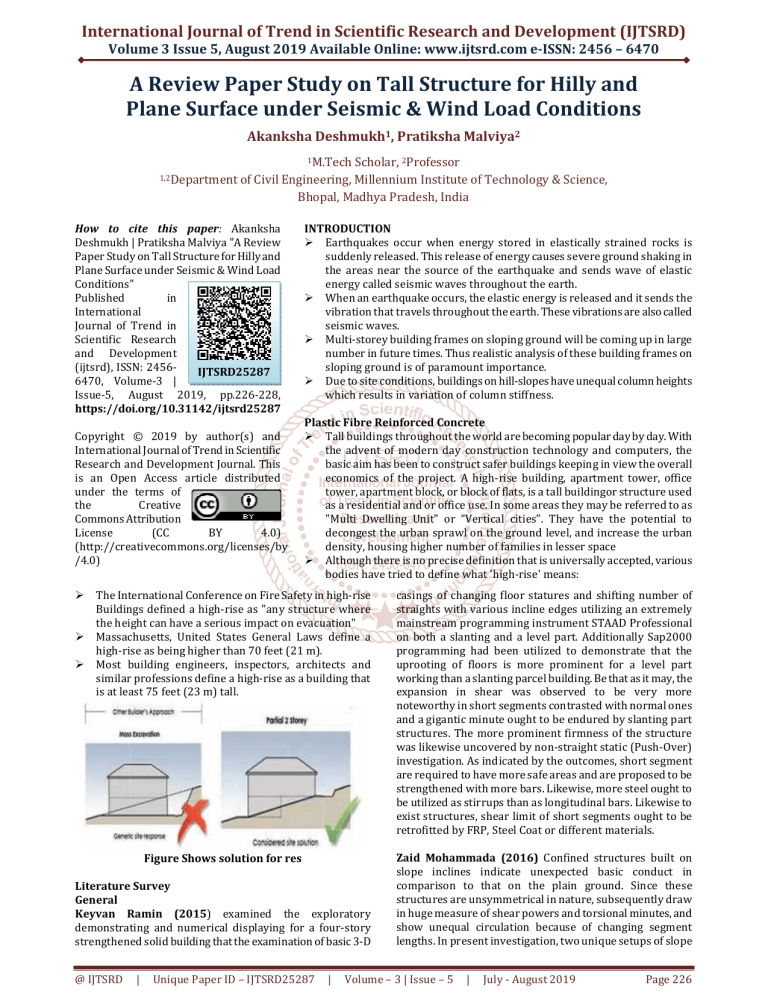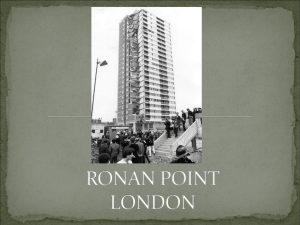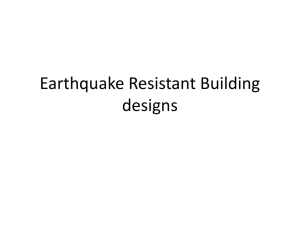
International Journal of Trend in Scientific Research and Development (IJTSRD)
Volume 3 Issue 5, August 2019 Available Online: www.ijtsrd.com e-ISSN: 2456 – 6470
A Review Paper Study on Tall Structure for Hilly and
Plane Surface under Seismic & Wind Load Conditions
Akanksha Deshmukh1, Pratiksha Malviya2
1M.Tech
Scholar, 2Professor
1,2Department of Civil Engineering, Millennium Institute of Technology & Science,
Bhopal, Madhya Pradesh, India
How to cite this paper: Akanksha
Deshmukh | Pratiksha Malviya "A Review
Paper Study on Tall Structure for Hilly and
Plane Surface under Seismic & Wind Load
Conditions"
Published
in
International
Journal of Trend in
Scientific Research
and Development
(ijtsrd), ISSN: 2456IJTSRD25287
6470, Volume-3 |
Issue-5, August 2019, pp.226-228,
https://doi.org/10.31142/ijtsrd25287
Copyright © 2019 by author(s) and
International Journal of Trend in Scientific
Research and Development Journal. This
is an Open Access article distributed
under the terms of
the
Creative
Commons Attribution
License
(CC
BY
4.0)
(http://creativecommons.org/licenses/by
/4.0)
INTRODUCTION
Earthquakes occur when energy stored in elastically strained rocks is
suddenly released. This release of energy causes severe ground shaking in
the areas near the source of the earthquake and sends wave of elastic
energy called seismic waves throughout the earth.
When an earthquake occurs, the elastic energy is released and it sends the
vibration that travels throughout the earth. These vibrations are also called
seismic waves.
Multi-storey building frames on sloping ground will be coming up in large
number in future times. Thus realistic analysis of these building frames on
sloping ground is of paramount importance.
Due to site conditions, buildings on hill-slopes have unequal column heights
which results in variation of column stiffness.
Plastic Fibre Reinforced Concrete
Tall buildings throughout the world are becoming popular day by day. With
the advent of modern day construction technology and computers, the
basic aim has been to construct safer buildings keeping in view the overall
economics of the project. A high-rise building, apartment tower, office
tower, apartment block, or block of flats, is a tall buildingor structure used
as a residential and or office use. In some areas they may be referred to as
"Multi Dwelling Unit" or “Vertical cities”. They have the potential to
decongest the urban sprawl on the ground level, and increase the urban
density, housing higher number of families in lesser space
Although there is no precise definition that is universally accepted, various
bodies have tried to define what 'high-rise' means:
The International Conference on Fire Safety in high-rise
Buildings defined a high-rise as "any structure where
the height can have a serious impact on evacuation"
Massachusetts, United States General Laws define a
high-rise as being higher than 70 feet (21 m).
Most building engineers, inspectors, architects and
similar professions define a high-rise as a building that
is at least 75 feet (23 m) tall.
Figure Shows solution for res
Literature Survey
General
Keyvan Ramin (2015) examined the exploratory
demonstrating and numerical displaying for a four-story
strengthened solid building that the examination of basic 3-D
@ IJTSRD
|
Unique Paper ID – IJTSRD25287
|
casings of changing floor statures and shifting number of
straights with various incline edges utilizing an extremely
mainstream programming instrument STAAD Professional
on both a slanting and a level part. Additionally Sap2000
programming had been utilized to demonstrate that the
uprooting of floors is more prominent for a level part
working than a slanting parcel building. Be that as it may, the
expansion in shear was observed to be very more
noteworthy in short segments contrasted with normal ones
and a gigantic minute ought to be endured by slanting part
structures. The more prominent firmness of the structure
was likewise uncovered by non-straight static (Push-Over)
investigation. As indicated by the outcomes, short segment
are required to have more safe areas and are proposed to be
strengthened with more bars. Likewise, more steel ought to
be utilized as stirrups than as longitudinal bars. Likewise to
exist structures, shear limit of short segments ought to be
retrofitted by FRP, Steel Coat or different materials.
Zaid Mohammada (2016) Confined structures built on
slope inclines indicate unexpected basic conduct in
comparison to that on the plain ground. Since these
structures are unsymmetrical in nature, subsequently draw
in huge measure of shear powers and torsional minutes, and
show unequal circulation because of changing segment
lengths. In present investigation, two unique setups of slope
Volume – 3 | Issue – 5
|
July - August 2019
Page 226
International Journal of Trend in Scientific Research and Development (IJTSRD) @ www.ijtsrd.com eISSN: 2456-6470
structures have been displayed and broke down utilizing
ETABS v 9.0 limited component codes. A parametric report
has been completed, in which slope structures are
geometrically differed in stature and length. Taking all things
together.
Rupali Kavilkar and Shweta Patil (2016) High-rise
structures are also called “vertical cities”, having the
potential to decongest urban sprawl. Indian cities are
witnessing immense demographic expansion due to
migration from surrounding villages, leading to urban
sprawl, housing demand, rise in cost of land. Housing has
developed into an economy generating industry. Given this
demand, while high-rise residential structures have become
a solution in the metropolitan cities, they remain eluded in
tier II cities in India. Low-rise or mid-rise high-density
dwelling types have developed in these cities. A study of
Pune city’s housing needs, demands, market, and type of
structures being built, reveal that tall buildings of 11 floors
are being developed on the city’s urban fringe. Most of the
high-rise projects remain as proposals. An investigation in
this case study reveal that high rise structures are not
preferred due to user perception of insecurity in case of fire
and high cost of the building. The paper aims at studying the
availability and use of fly ash in various proportions, which
can be used in Indian high-rise residential buildings. The
research paper indicates that fly ash concrete can be used to
reduce the cost of construction and has the potential to
minimize the damage caused due to high temperature.
Roser J. Robert and Ranjana M. Ghate (2016) made a
comparison between the behaviour of G+4 storey building
rested on sloped surface and on flat surface with same
intensity of seismic load on both the buildings. They are
mainly focused on storey displacement and base shear of
buildings have been evaluated in +X and –X direction as well
as in +Z and –Z direction. They conclude that i). The story
displacement is 10% more in Flat surface in X direction and
30% more in sloped surface in Z direction. ii). Base shear is
7.45% more in Flat surface than sloped surface. iii). number
of storey increases storey displacement decreases in both
buildings iv) building rested on sloped surface is more
vulnerable than building rested on flat surface during seismic
effect.
A Joshua Daniel and S Sivakamasundari (2016) made a
comparative study of three setback buildings of Type A
building is stepping back at every floor level on the slope, up
to 4 storeys and has two storeys above road level. The Type B
building is stepping and setting back at every floor level. The
Type C buildings is stepping back at fourth floor level only
and has two storeys above road level having weight and plan
same as with the regular building resting on flat ground. He
concluded that, i). From the cumulative modal mass
participation ratio, the energy dissipation of regular building
on flat ground is higher than the respective hill building. ii).
Flexibility of regular building endures larger displacement
than building resting on hill.
Akhil R (2017) made a comparative study to better
understand of regular and irregular structure response to
incoherent ground motion. The modeling of regular and
irregular building for zone V of G+10 is analyzed .The main
aim of his work is comparative study about the stiffness of the
regular and irregular configuration. A geometric irregularity
introduces discontinuities in distribution of mass, stiffness
@ IJTSRD
|
Unique Paper ID – IJTSRD25287
|
and strength along vertical direction needs to work in these
regarding area. Author made an attempt to reach on more
accurate conclusion to reduce their effect on structure.
Among these regular and irregular, he identifies the best
configuration from his analysis. It was concluded that
response spectrum analysis allows clear understanding of
contributions of different modes of vibration. Comparing the
results, it was concluded that base shear and displacement are
maximum in regular building.
Esther (2018) generated different types of analytical models
using STTAD. He made an attempt on vertical geometrical
irregularities of 6 storeys, 8 storeys and 10 storeys with a
range of 0 to 75 % irregularities with interval of 25%.For each
case he studied member forces such as bending moment, shear
force, displacement, and drift. From his study he concluded
that i). Shear force and bending moment is maximum in 75%
irregularity i.e., irregularity increases Sharon bending
moment and shear force increases. ii). Drift also increases
with irregularity of building increased if it exceeds 0.10 it
leads to collapse. iii). The maximum displacement of 75 %
increased by 75% irregularity and 65% with plus shape
without irregularity.
In this thesis, seismic analysis of building is done at two
different grounds plane and hilly (i.e., 0o, and 150).
Comparison of footings in terms of horizontal reaction,
vertical reaction and bending moment is carried out at above
mentioned sloping ground. Also axial force and bending
moment in columns, shear force and bending moment in
beams is compared, Lateral displacement and drift is also
compared.
Problem identification
Review of different papers related to the subject was done.
Some problems were identified such as: In past, researchers have studied the shear behavior of
multi storey buildings for different seismic zones.
Design of earthquake resistant multi storey RCC building
on sloping ground with varying of floor height and
number of bays was done.
Objectives
The objectives of the research are outlined below:
To analyses problems of Tall RCC building considering
earthquake Zone III in different geometries using Staad
Pro V8i software.
CONCLUSION
Analysis results indicate the effect of sloping ground on
performance of structure. This study may be useful to
improved design and construction practice for structures
resting on sloping ground.
REFERENCES
[1] Bozorgnia Y, Bertero V, "Earthquake Engineering: From
Engineering Seismology to Performance-Based
Engineering", CRC Press,2004.
[2] ChandwaniVinay, AgrawalVinay, Gupta and Naveen
Kumar (2012), “Role of Conceptual Design in High Rise
Buildings.”, Vol. 2, Issue 4, July-August 2012, pp.556560.
[3] Emraherduran (2008), “Assessment of current
nonlinear static procedures on the estimation of
torsional effects in low-rise frame buildings in sloping
Volume – 3 | Issue – 5
|
July - August 2019
Page 227
International Journal of Trend in Scientific Research and Development (IJTSRD) @ www.ijtsrd.com eISSN: 2456-6470
ground”, Engineering Structures 30 (2008):2548-2558.
[4] Gourabi, A. and Yamani, M. (2011) Active Faulting and
Quaternary Landforms Deformation Related to the
Nain Fault on sloping ground. American Journal of
Environmental Sciences, 7,441-447.
[5] Guan Y.H., et al. (2011) Studied on the Earthquake
Disaster Reduction Information Management System
and Its Application. International Journal of Intelligent
Systems and Applications, Vol-1, pp51-57.
[6] Hajra B and Godbole P.N. (2006). “Along Seismic Load
on Tall Buildings Indian Codal Provisions.” 3NCWE06
Kolkata, pp285-292.
[7] IS 1893 (Part-I) 2002: Criteria for Earthquake
Resistant Design of Structures, Part-I General
Provisions and Buildings, Fifth Revision, Bureau of
Indian Standards, New Delhi.
[8] IS 875(1987), Indian Standard Code of practice for
Design loads for buildings and structures, Bureau of
Indian Standards, New Delhi. Ashraf Habibullah,
Stephen Pyle, Practical three-dimensional non-linear
static and dynamic analysis, Structure Magazine,
@ IJTSRD
|
Unique Paper ID – IJTSRD25287
|
winter, 1998 FEMA-356(2000), Pre standard and
Commentary for the seismic Rehabilitation of
buildings, American Society of Civil Engineers,USA.
[9] K. Al-Kodmany and M. Ali “Skyscrapers and place
making supporting local culture and identity,” Archnet
IJAR International Journal of Architectural Research,
vol. 16, issue 2 , July 2012.
[10] K. Rangawala “Contextual tall buildings in India,”
CTBUH 2010 World Conference – India, Remaking
Sustainable cities in the vertical age, Feb. 3rd-5th 2010.
[11] KazemShakeri (2018),”An adaptive modal pushover
procedure for asymmetric-plan buildings”, Engineering
Structures 36 (2012), pp.160-172.
[12] Kumar, S., and Paul, D.K. (1998). A Simplified Method
for Elastic Seismic Analysis of Hill Buildings. Journal of
Earthquake Engineering 2 :( 2),241-266.
[13] Lee Han Seon ,Dong Woo Kee, 2007, Seismic response
characteristics of high-rise RC wall buildings having
different irregularities in lower stories with sloping
ground, Engineering Structures 29(2007):3149–3167.
Volume – 3 | Issue – 5
|
July - August 2019
Page 228





